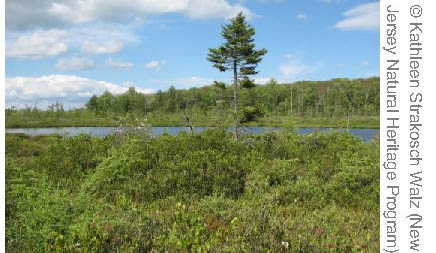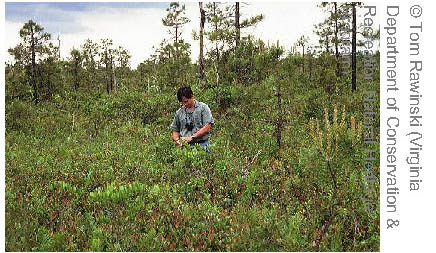The Coastal plain peatland macrogroup consists of the following habitats:
Atlantic Coastal Plain Northern Bog


Regional distribution:
MA, NJ, NY. 5,260 total acres of habitat, of which 71.6% is conserved.
Description:
A small bog dominated by dwarf-shrubs that occur in the heart of the northern coastal plain, often in conjunction with pine barrens. They develop on acidic, tannic water supporting a floating or grounded peat mat over which leatherleaf, dwarf huckleberry, and other dwarf-shrubs have rooted. Taller shrubs such as highbush blueberry may occur at the periphery of the bog, and swamp loosestrife (water willow) often forms a distinct zone adjacent to open water. Aquatic plants such as water lily occur in open water.
Download the
pdf for this habitat for information about species, crosswalks to state names, and condition of this habitat.
Atlantic Coastal Plain Peatland Pocosin and Canebrake


Regional distribution:
VA. 2,274 total acres of habitat, of which 99.1% is conserved.
Description:
A shrub-dominated wetland on the outer terraces of the Mid Atlantic coastal plain, occurring in small to large basins and swales, and only in the very southeast corner of our region. Characteristically, a suite of evergreen shrubs, greenbriars, and pond pine dominates, forming dense scrublands or shrubby open woodlands (pocosins). Shrubs include inkberry, fetterbush, staggerbush, littleleaf titi, big gallberry, honeycups, and laurel greenbrier. Pond pine is the characteristic tree, along with loblolly-bay, sweetbay, and swamp bay. Herbs are scarce and largely limited to small open patches. Soil saturation, sheet flow, and peat depth
create a distinct zonation, with the highest stature woody vegetation on the edges and the lowest in the center.
Download the
pdf for this habitat for information about species, crosswalks to state names, and condition of this habitat.